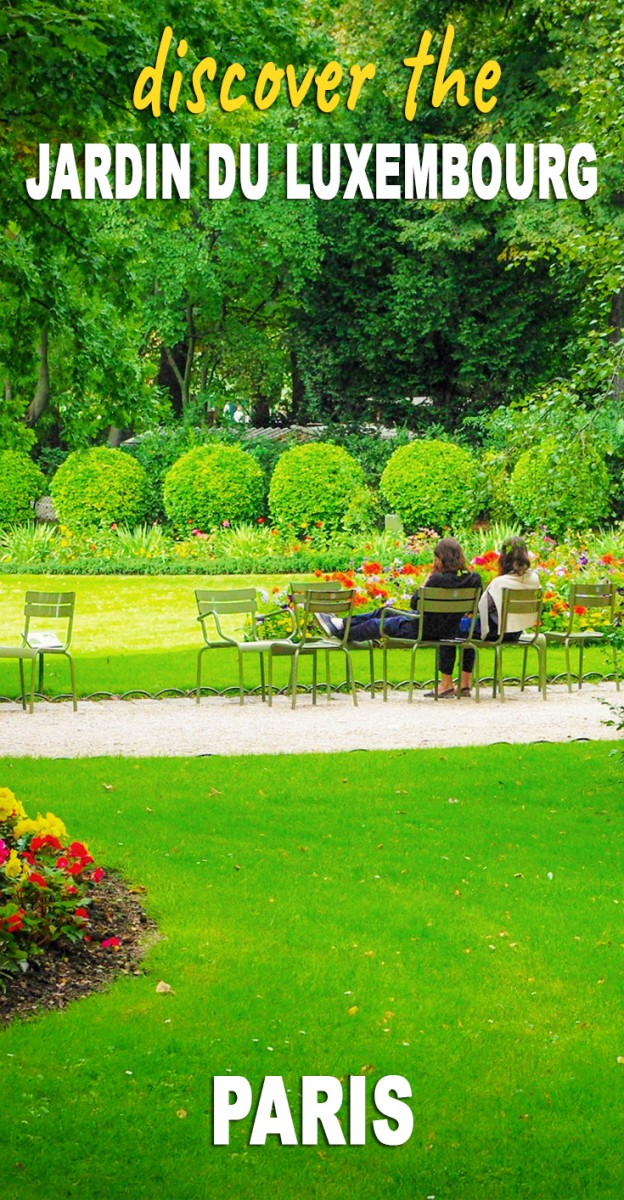Among Paris’s many parks and gardens, the Jardin du Luxembourg (Luxembourg Gardens) is undoubtedly one of my favourites.
It is also a much-appreciated green space for Parisians, students, and tourists.
It’s easy to fall in love with the gardens.
They are a fascinating place, an “oxygen bottle” in the centre of the French capital.
Visitors enjoy the greenery punctuated with many statues, flowerbeds, tree-lined promenades, playgrounds, and the famous Guignol puppet show.
Come along, and I’ll show you the place.
Where is the Jardin du Luxembourg?
The Jardin du Luxembourg is part of the 6th arrondissement.
The park owes its popularity to its magnificent trees, particularly the grand horse chestnut trees and the paulownias.
A little orangery hosts rosebays, palm trees, camphor trees, and pomegranate trees.
Le Nôtre designed an open space at the centre of the garden.
The formal garden is organized around an octagonal basin.
It borders the South façade of the Luxembourg Palace and creates a perspective of the Paris Observatory.

The formal gardens cover most of the Jardin du Luxembourg (French for Garden of Luxembourg).
Traditionally it is a gathering site of Parisian high society.
It also offers a resting space in the English garden located along the rue Guynemer and rue Auguste-Comte.
This is where you’ll find orchids and vines.
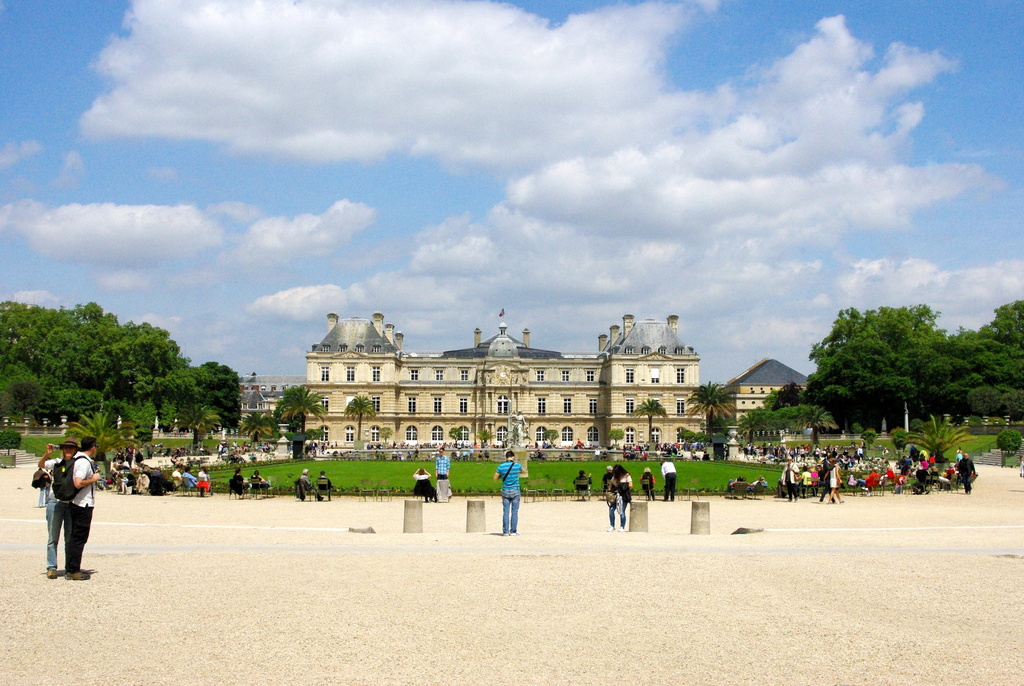
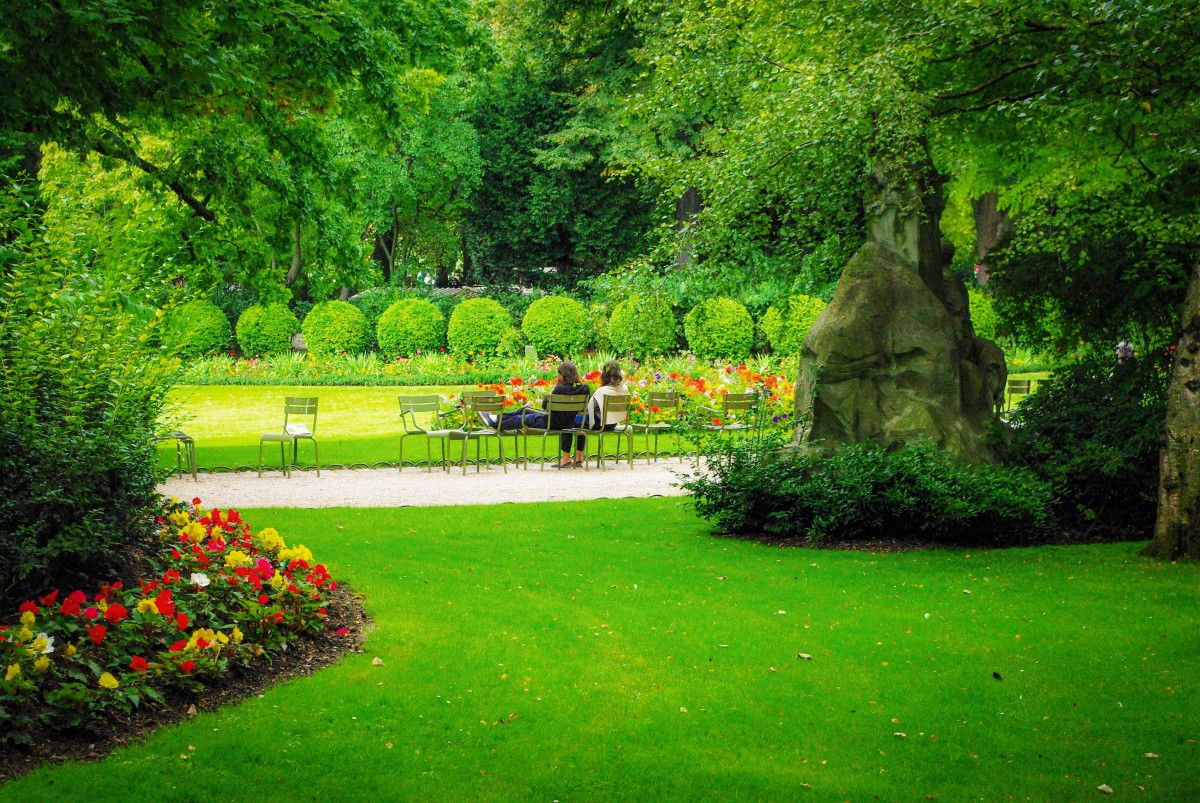
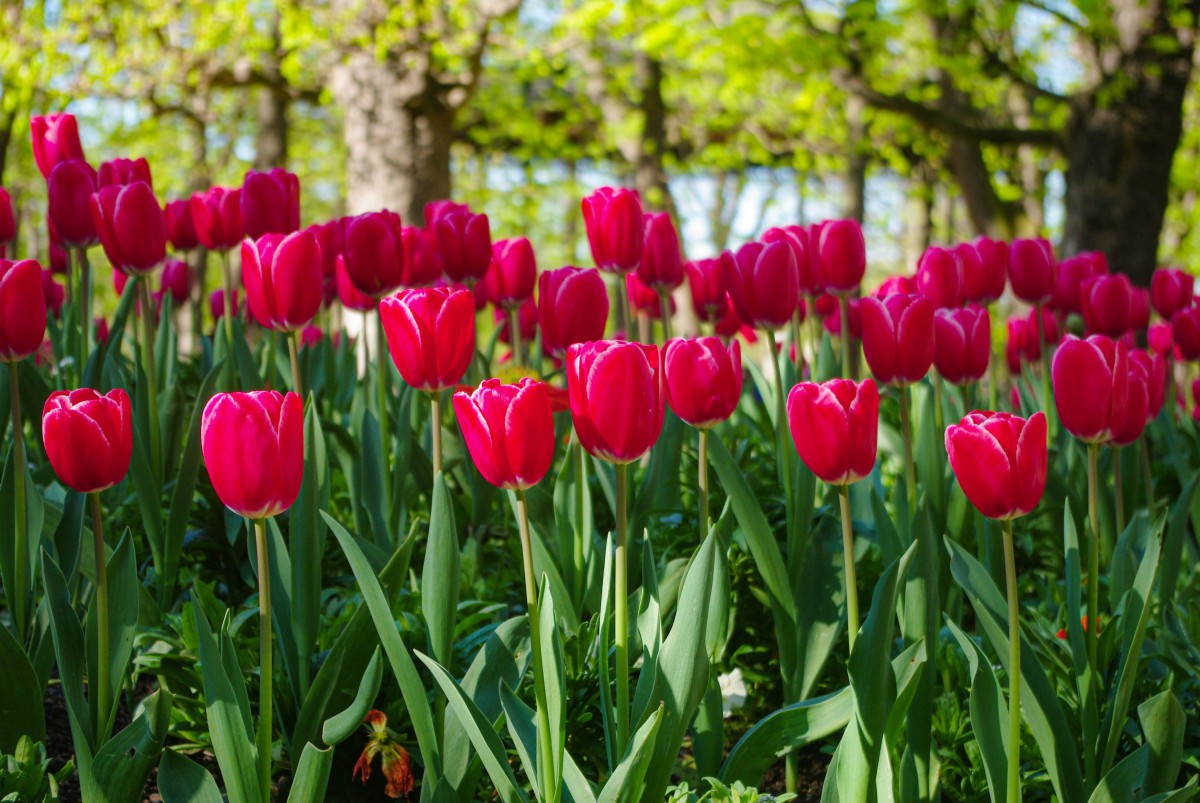
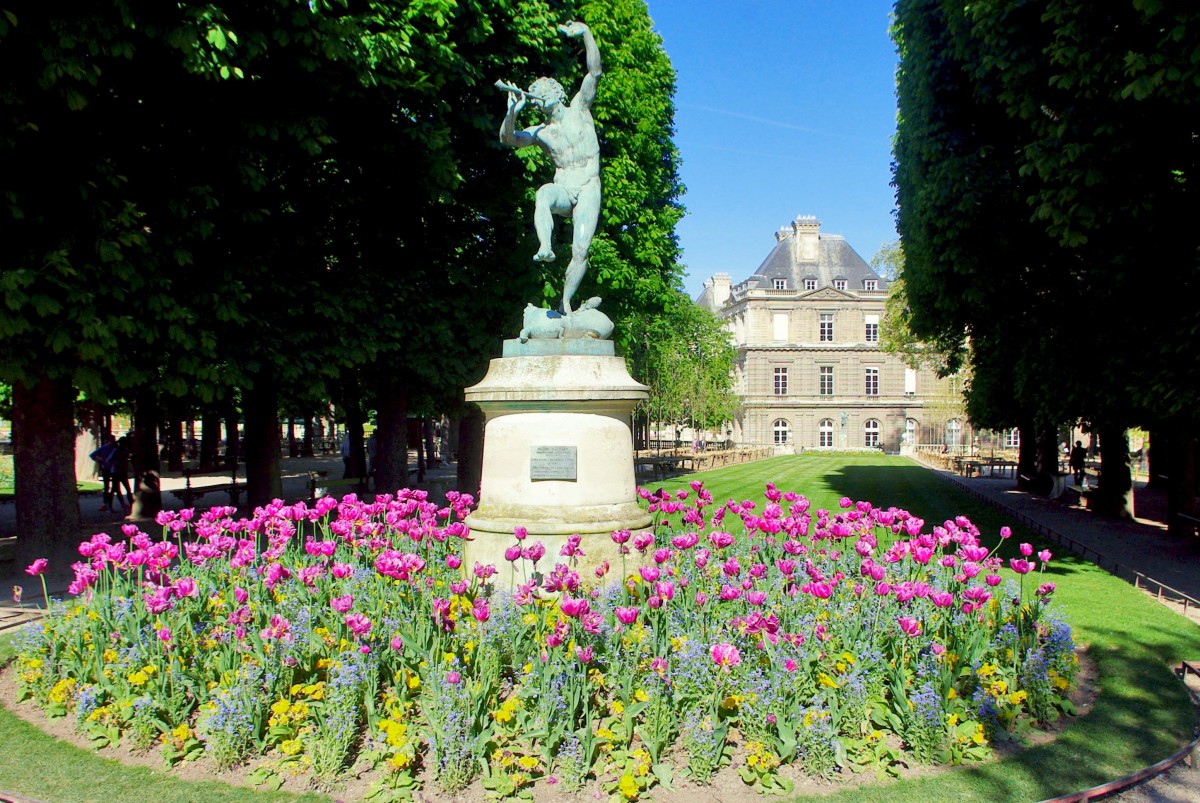
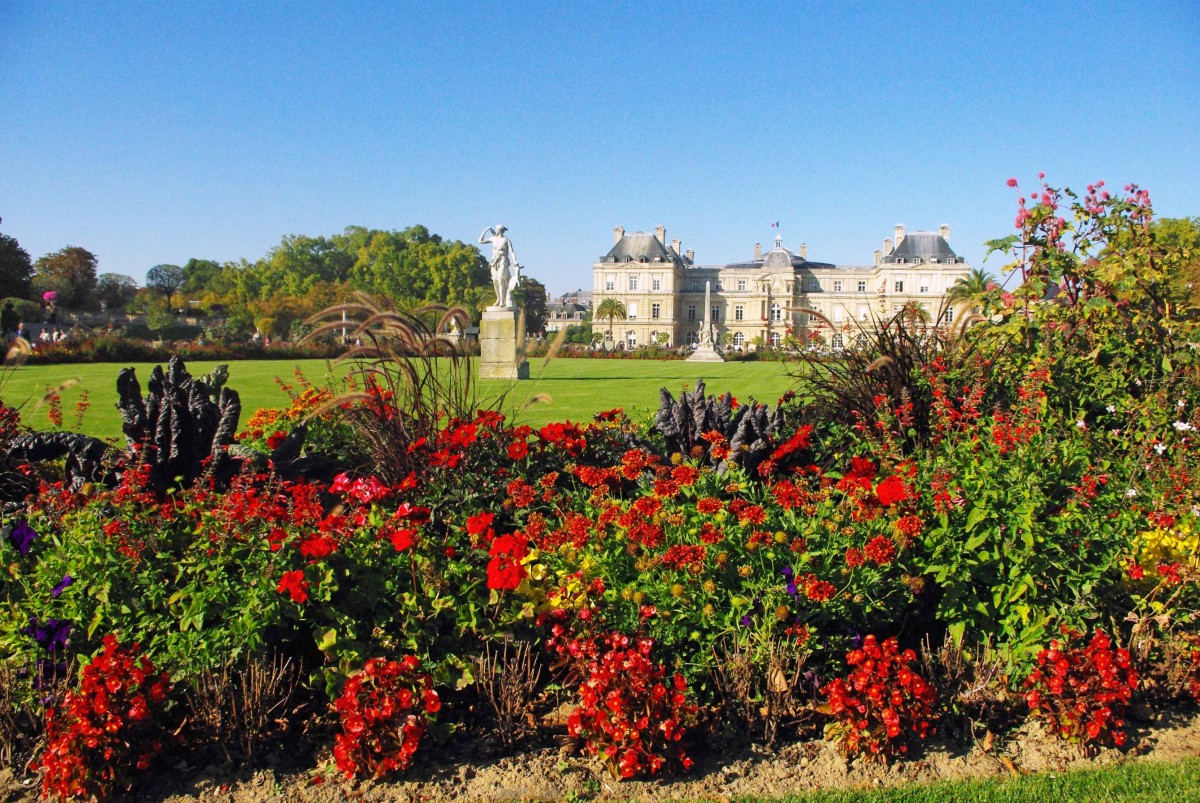
History of the Luxembourg Gardens
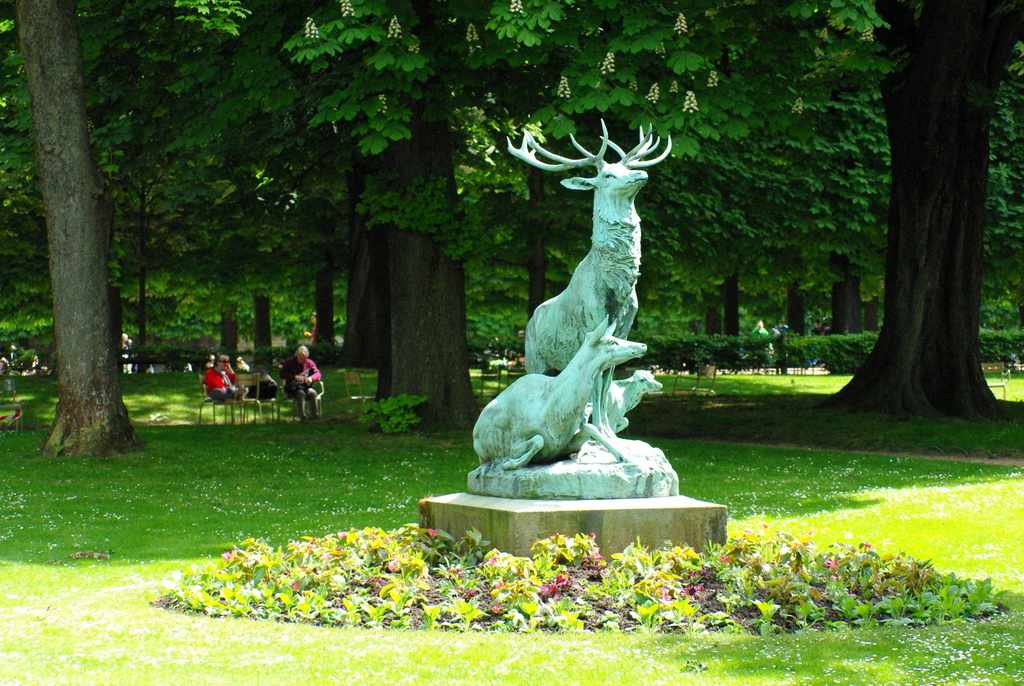
The Luxembourg Gardens were created in 1617.
They owe their name to the Duke of Piney-Luxembourg, the domain’s first landlord.
The Mark of Maria de’ Medici
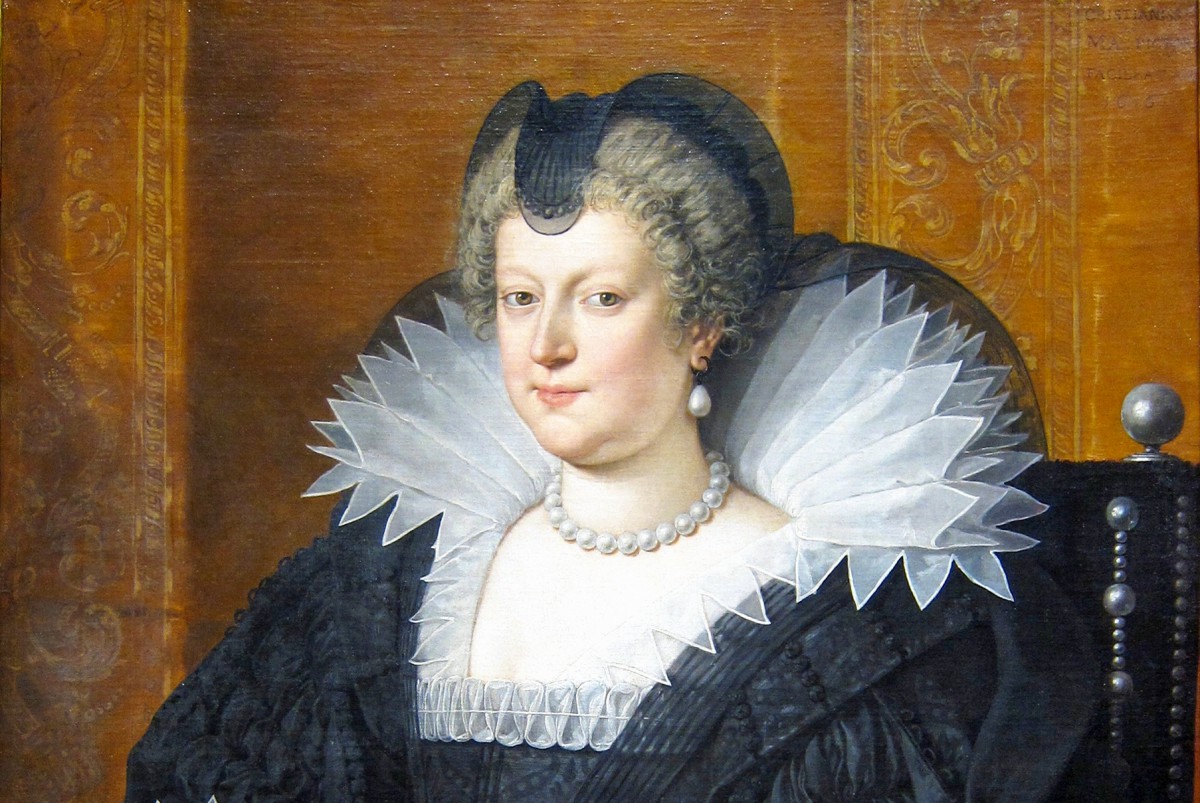
Maria de’ Medici, widow of the King of France, Henri IV, later acquired the estate.
The Italian-born Queen wished to create a building that would remind her of the Pitti Palace and establish gardens evoking those of Boboli in Florence.
Maria commissioned the construction of the palace (current Luxembourg Palace) from Salomon de la Brosse.
The new edifice opened onto an 8-hectare park.
More than 2,000 elm trees were planted, and large flower beds were laid out.
The recently built Arcueil aqueduct fed the fountains with fresh water.
The Medici fountain
One of the most beautiful settings in the gardens is the Medici fountain.
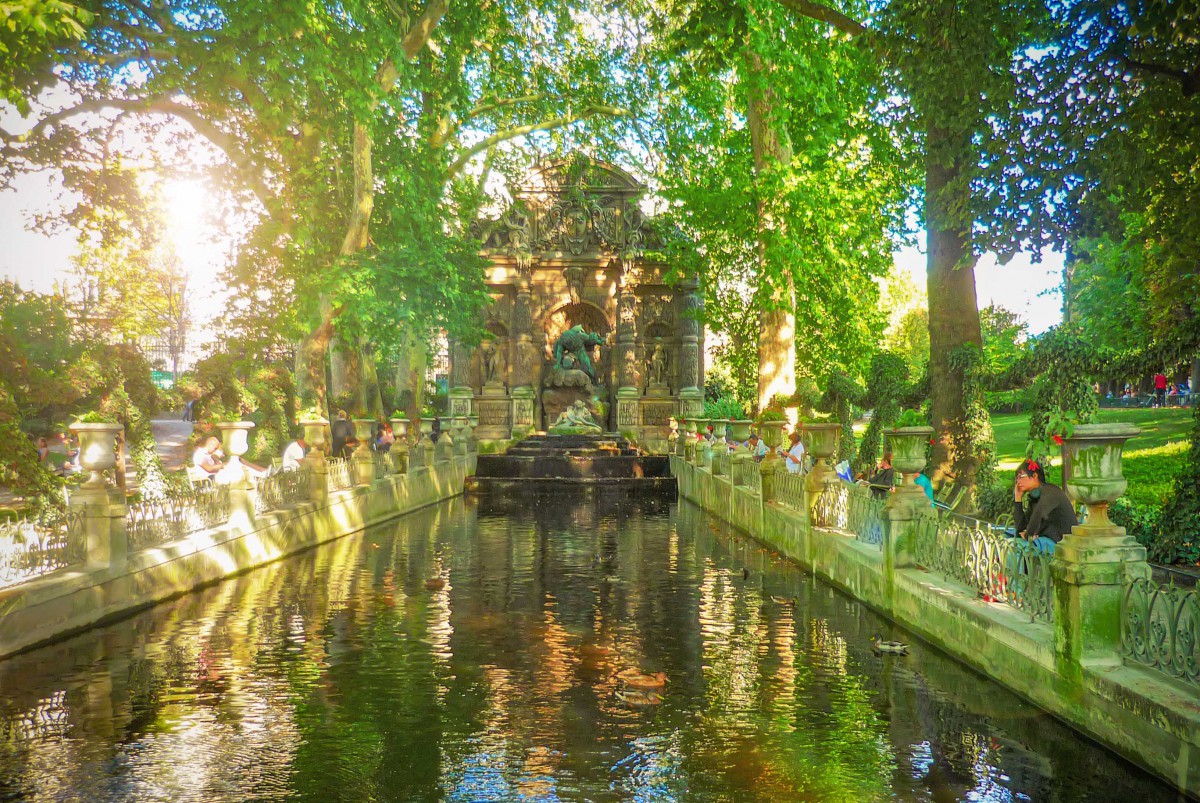
It can easily be missed if you don’t walk to the east side of the palace.
It’s probably the most famous fountain in the park.
It dates back to the 1630s when Maria de’ Medici Florentine commissioned its construction from engineer Thomas Francine.
Initially named “Luxembourg Grotto”, it features an Italian-style portico to which the garden architects added a fountain and a lengthened basin.
However the fountain you now see has been altered several times since the 17th century. In 1863, Auguste Ottin decorated it with a group of three mythological characters:
“Polyphemus catching Galatea by surprise in the arms of Acis”.
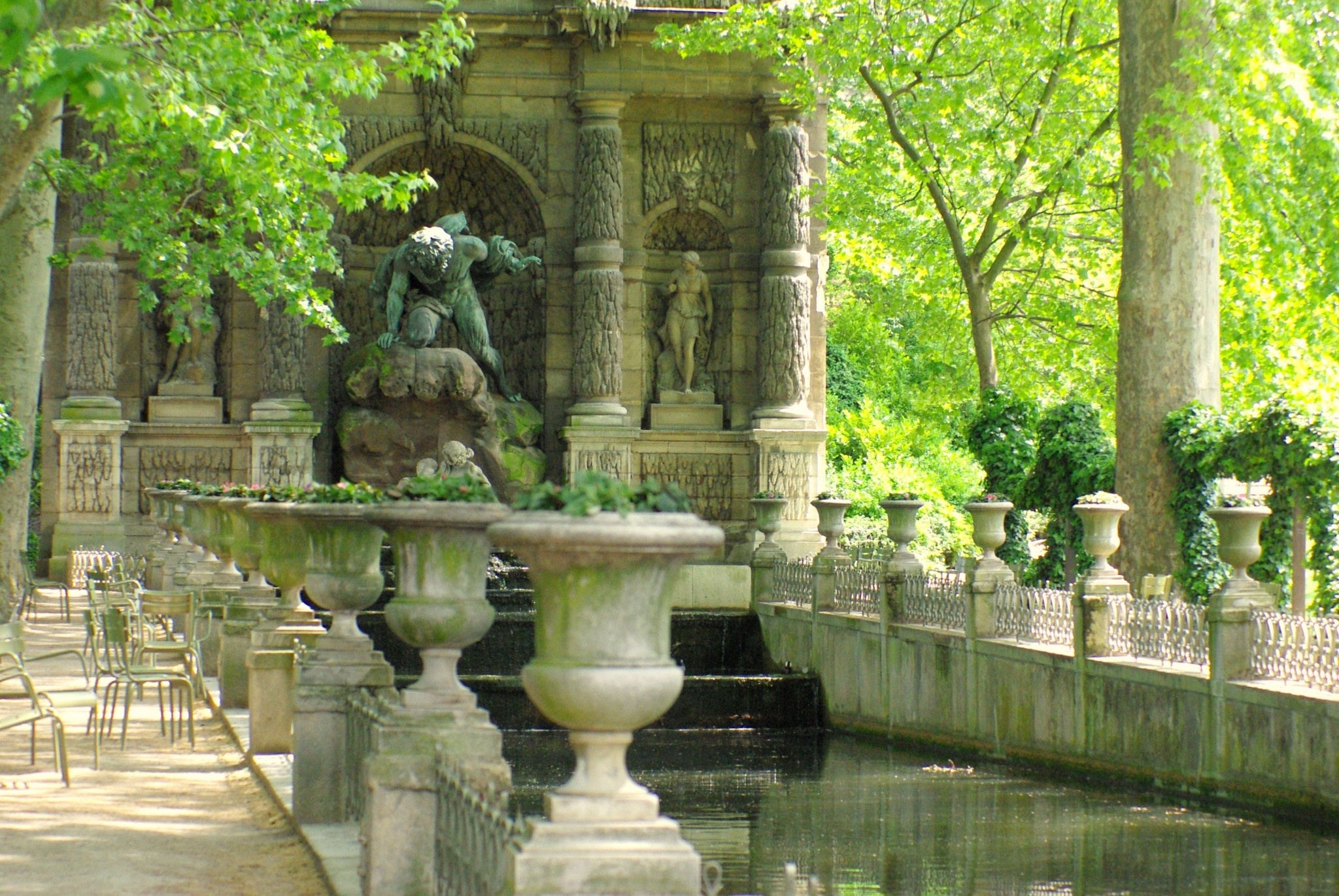
In the central niche, you’ll discover the story of Polyphemus in love with Galateais.
Crouched down, the Cyclops is about to crush the young and beautiful goddess of the sea in the arms of Acis.
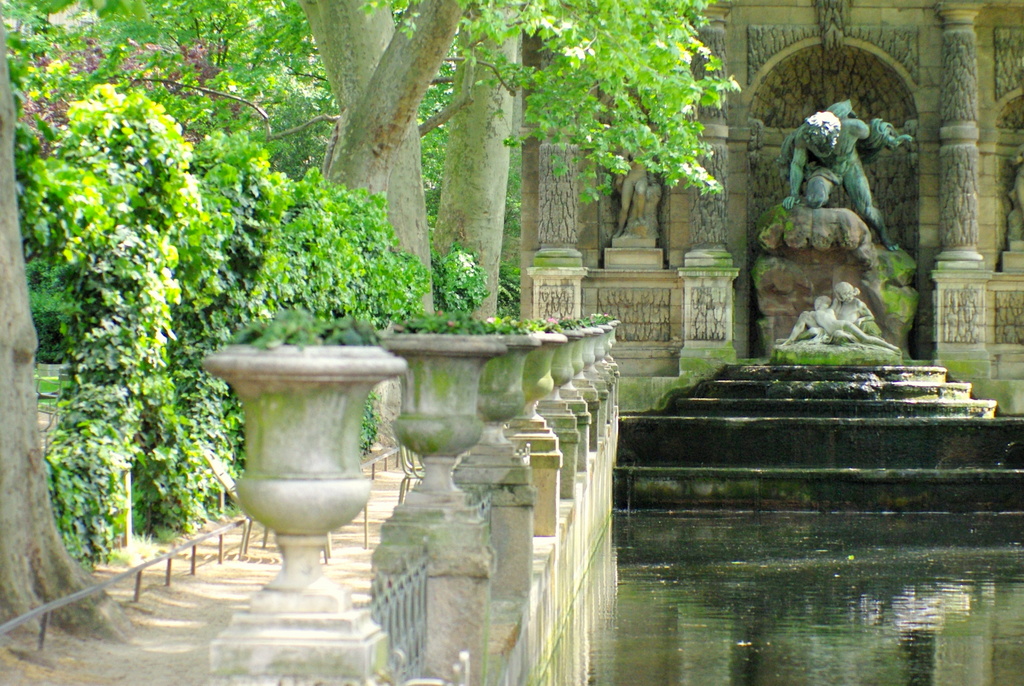
The Medici Fountain escaped demolition!
In 1862, the gardens’ neighbourhood underwent a massive restructuring in accordance with Baron Haussmann’s great urban works.
The construction of the new rue de Médicis led to great changes in the gardens.
Under Haussmann’s direction, urban planners removed the fountain stone by stone and re-assembled it 30 metres closer to the palace.
They also created a 50 m-long basin bordered by plane trees and flower pots in stone.
That’s why the basin in front of the fountain shows a beautiful green setting.
Its long shape gives the illusion of a water setting.

Also, as part of the urban restructuration, city planners moved the Léda Fountain, which was located on the corner of Rue du Regard and Rue de Vaugirard.
It found its place against the rear of the Medici fountain’s portico.
The touches of Le Nôtre
The garden has been modified and extended several times.
Architect Le Nôtre constructed a big octagonal basin in the centre of the formal garden on which little boats drift.
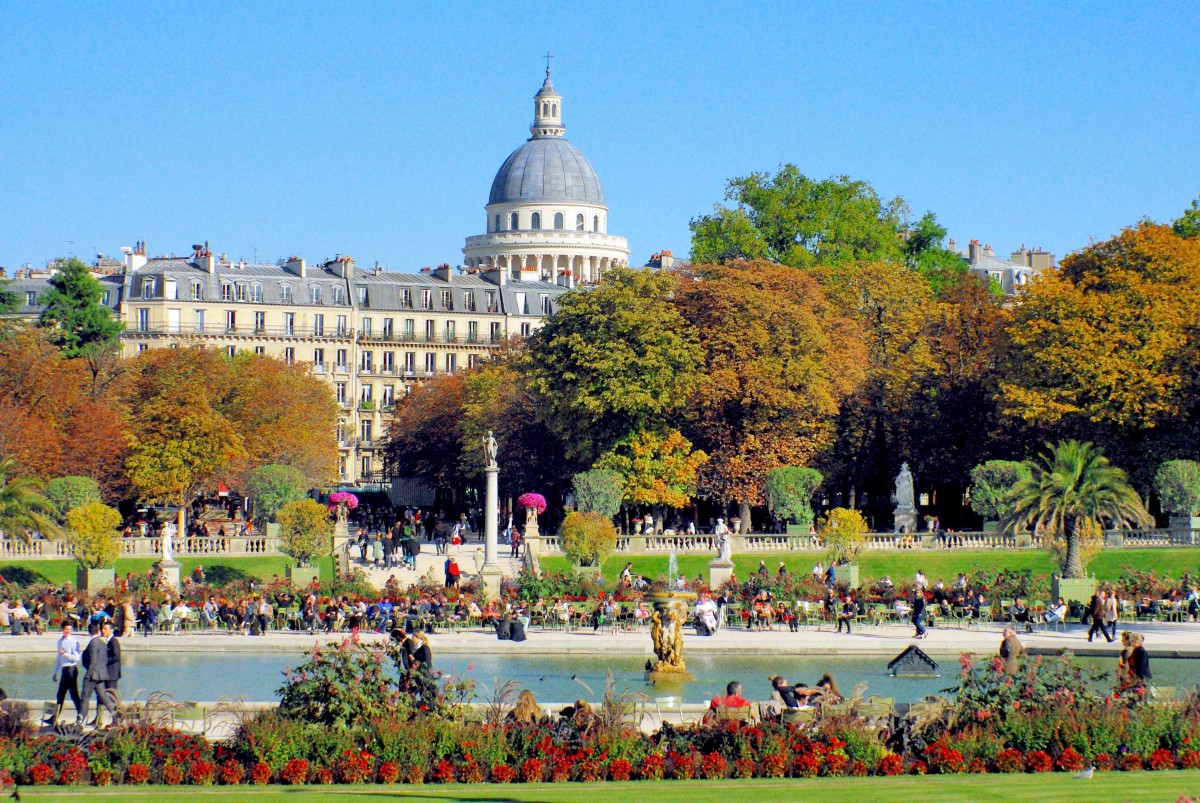
From the garden designed for Maria de Medici, almost nothing remains today apart from the orangery and the Medicis Fountain of Florentine inspiration.
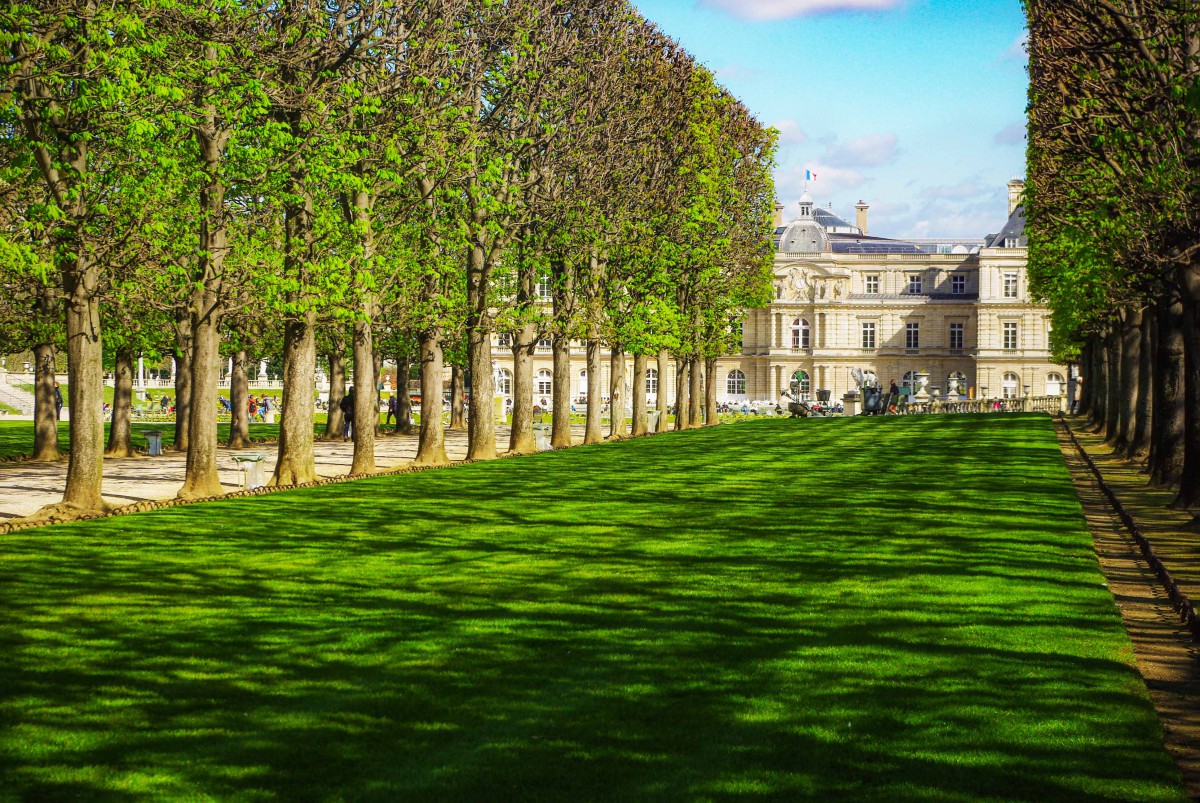
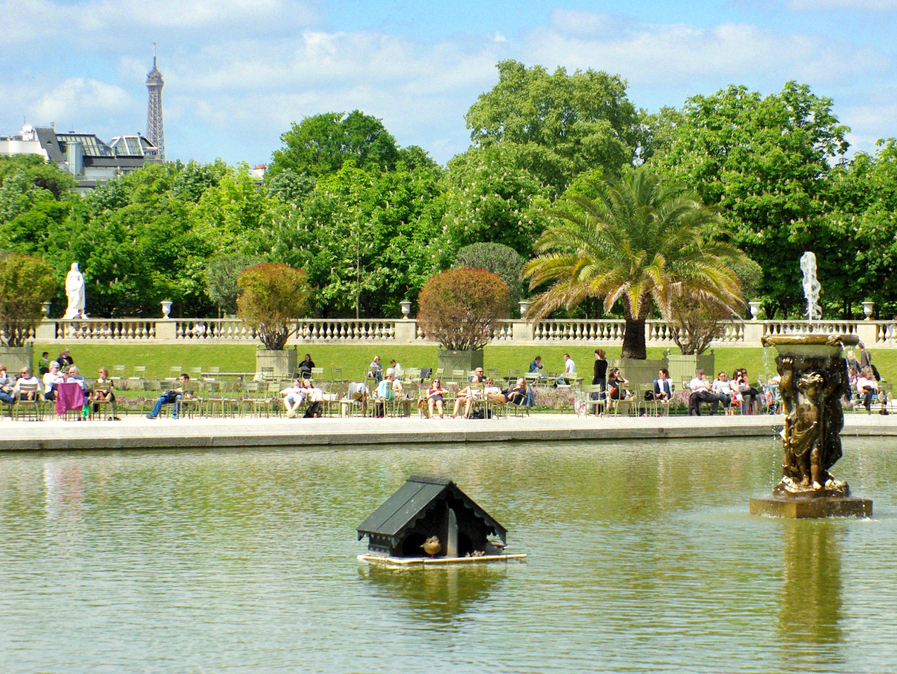
From 1810, the gardens along the Avenue de l’Observatoire extended the park’s green area to the south.
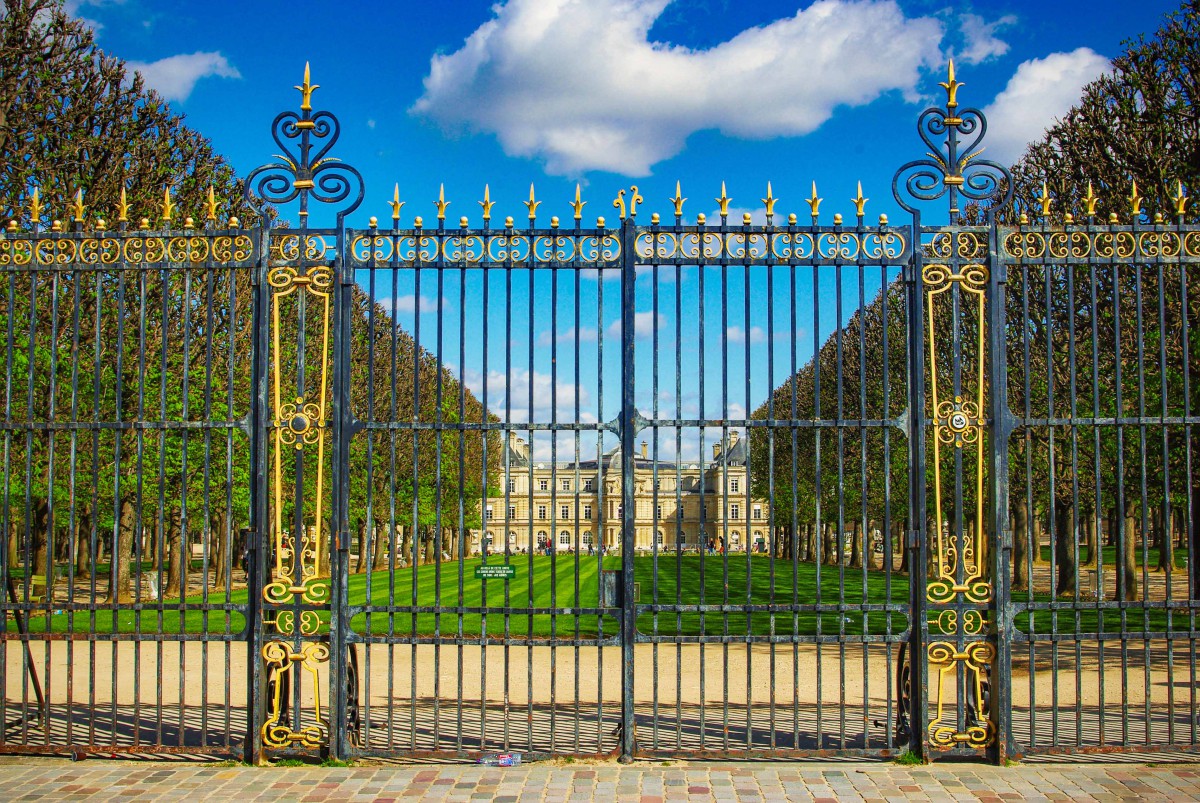
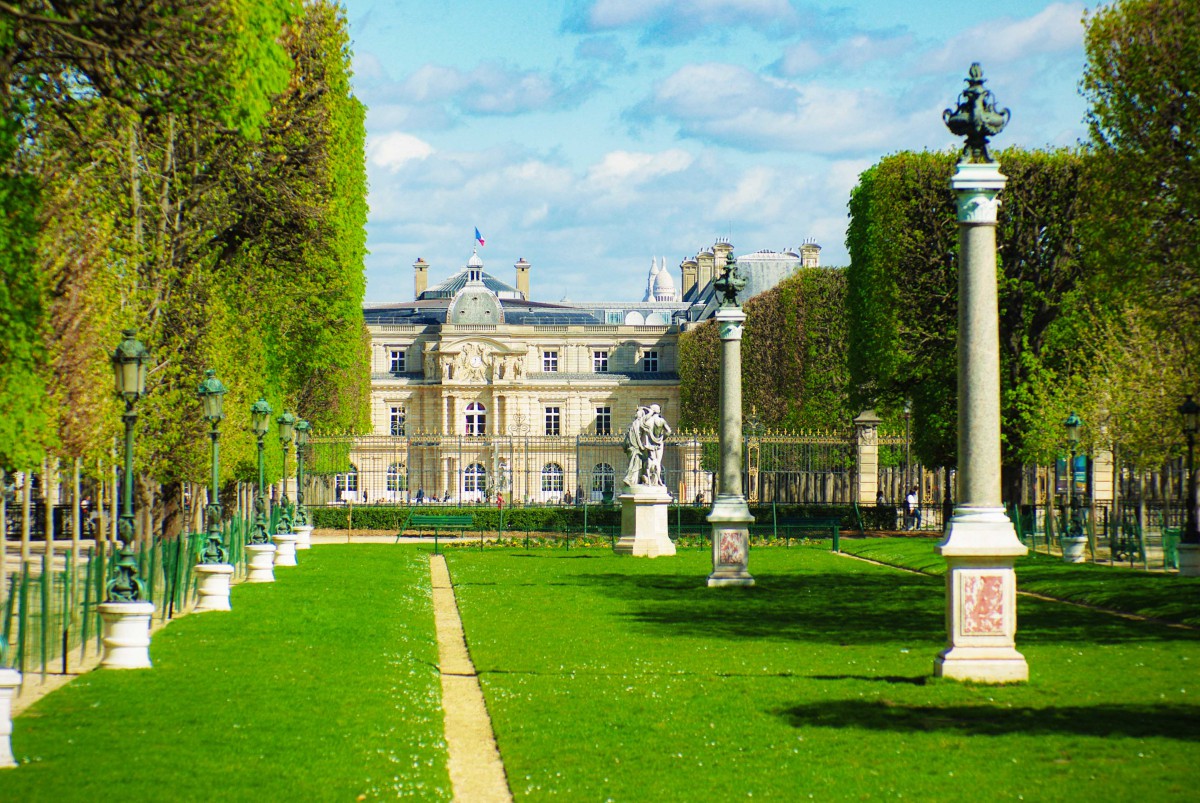
A public park opened to the public in 1642!
In 1642, Gaston of Orléans opened the park to the public. He was the younger brother of Louis XIII, who inherited the space.
The first visitors were local bourgeois, clerics, intellectuals and nannies who had to rent chairs from a lady in front of the palace.
Today, the park is the favourite green space of students from the universities of the 5th arrondissement.
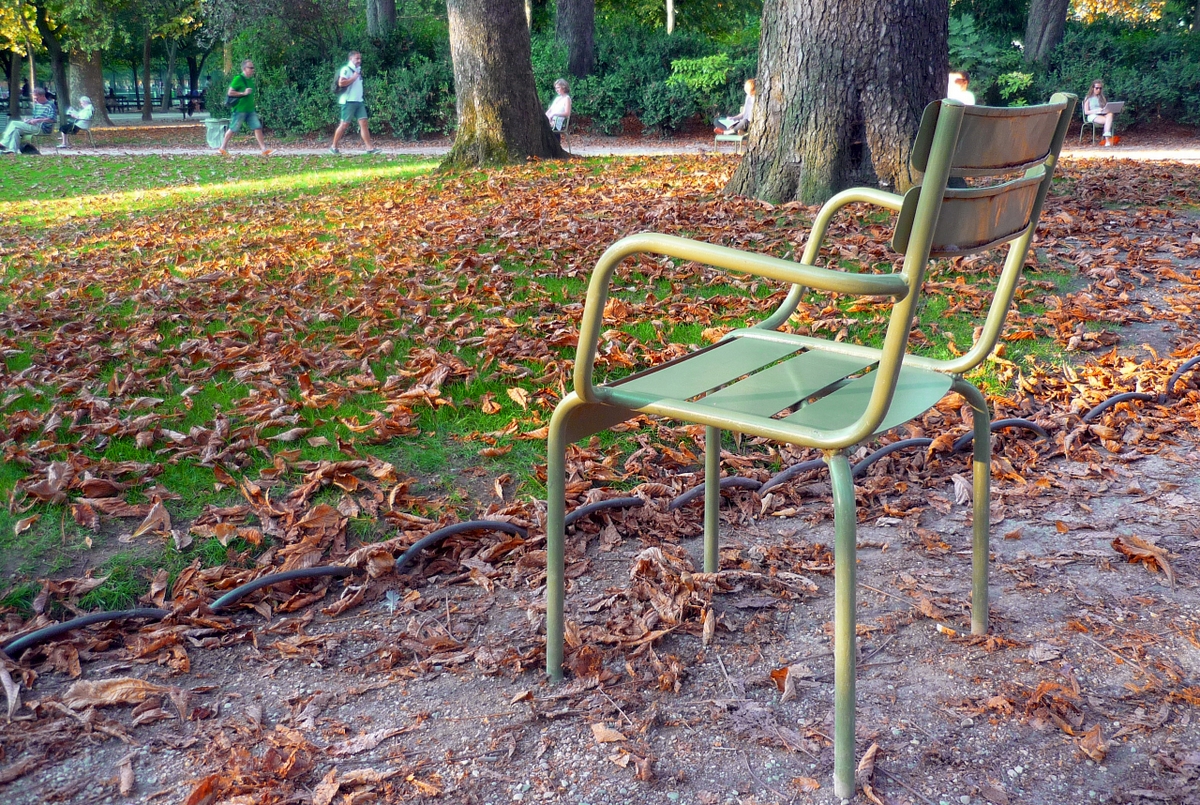
Before 1974, using the iconic chairs in the park was costly.
You had to pay a fee to women called “les chaisières” to sit on them.
This is one of the many professions that disappeared over 40 years ago…
The statues of the Luxembourg Gardens
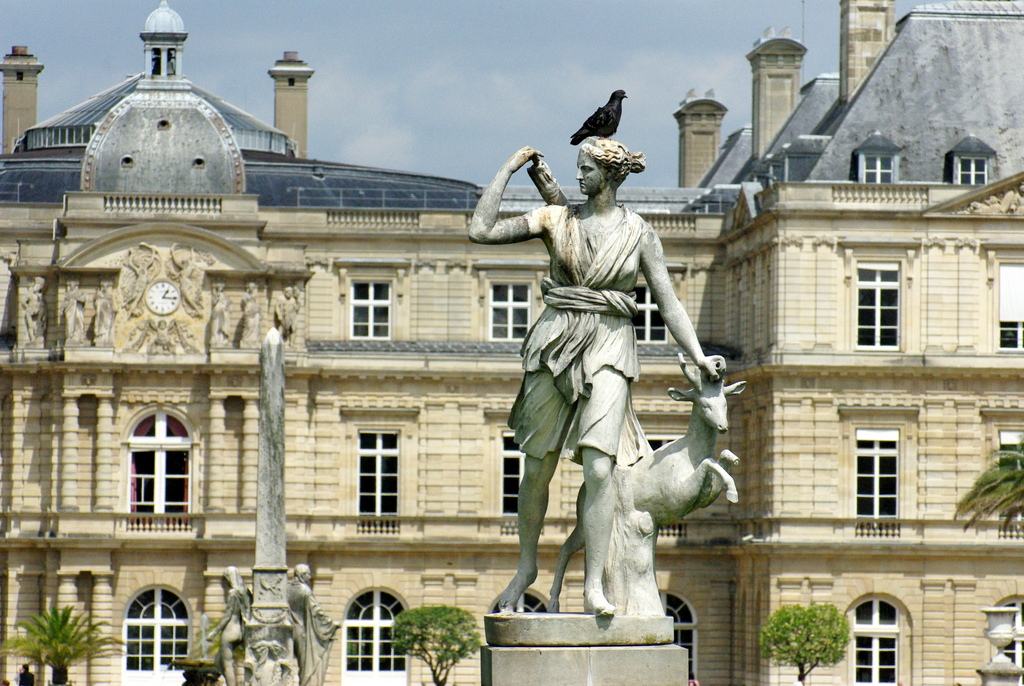
While strolling in the Jardin du Luxembourg, you’ll be amazed at the multitude of statues scattered throughout the park.
Of the 106 statues in the garden, most date back to the reign of Louis-Philippe (19th C.), who wished to add to the romantic character of the site.
The statues of the Queens of France
This is the case for the famous statues of the “Queens of France and famous women” (Reines de France et Femmes Illustres).
King Louis Philippe (reign 1830-1848) launched the project in 1843, gathering some of the greatest sculptors of the time.
It is a series of 20 white marble sculptures set out on the right and left terraces around the great basin.
Each statue measures between 2.30 and 3.80 metres in height and stands on a stone pedestal that indicates the name, its function, and the date of the person’s birth and death.
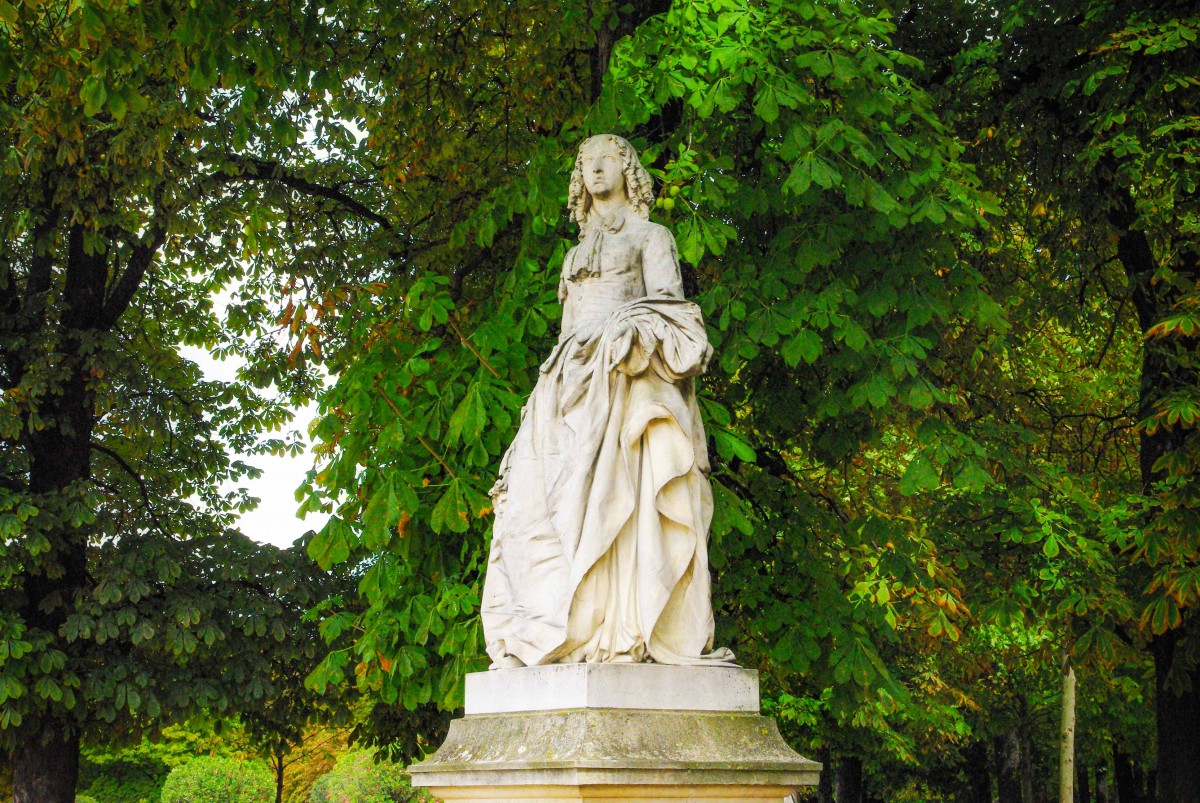
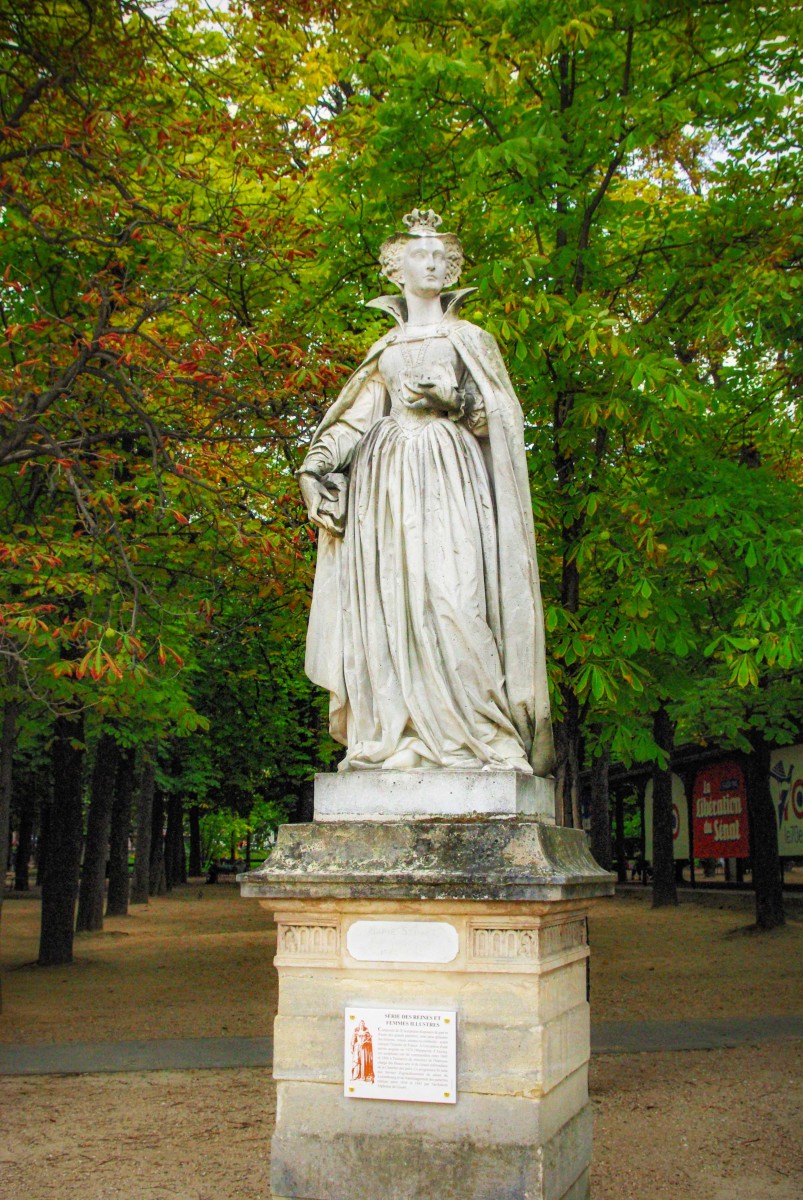
Here’s the list of the 20 queens and famous women:
Anne of Austria, Anne of Brittany, Anne of France, Anne Marie Louise of Orléans, Bertha of Burgundy, Blanche of Castile, Clémence Isaure, Jeanne III of Navarre, Laure de Noves, Louise of Savoy, Margaret of Anjou, Margaret of Provence, Marguerite of Navarre, Marie de’ Medici, Mary, Queen of Scots, Matilda, Duchess of Normandy, Saint Bathild, Saint Clotilde, Saint Genevieve, and Valentina Visconti.
… and their locations around the central basin:
![Queens of France Statues at the Luxembourg Garden © LPLT - licence [CC BY-SA 3.0] from Wikimedia Commons](https://frenchmoments.eu/wp-content/uploads/2012/11/Queens-of-France-Statues-at-the-Luxembourg-Garden-©-LPLT-licence-CC-BY-SA-3.0-from-Wikimedia-Commons.jpg)
What about Joan of Arc?
Interestingly, the series initially included a statue of Joan of Arc by François Rude.
As it was considered too fragile to remain outdoors, authorities moved it to the Louvre in 1872.
Instead, the French government commissioned a new statue from Taluet: Margaret of Anjou, completed in 1877.
The Statue of Liberty
The most unusual statue in the park in 1906 is arguably that of the Statue of Liberty.
The replica is a donation to its sculptor, Frédéric Auguste Bartholdi.
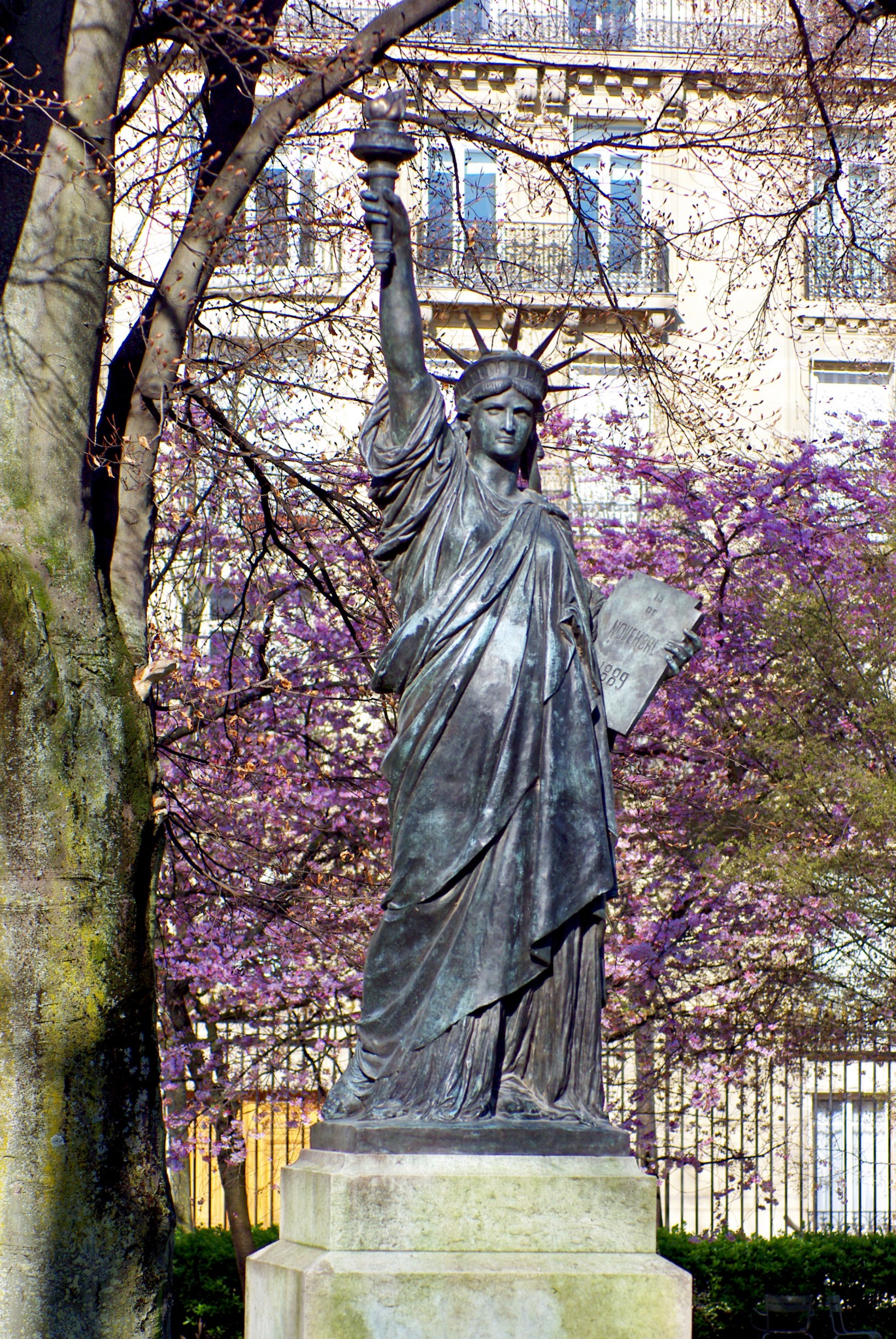
Jardin du Luxembourg: a leisure centre
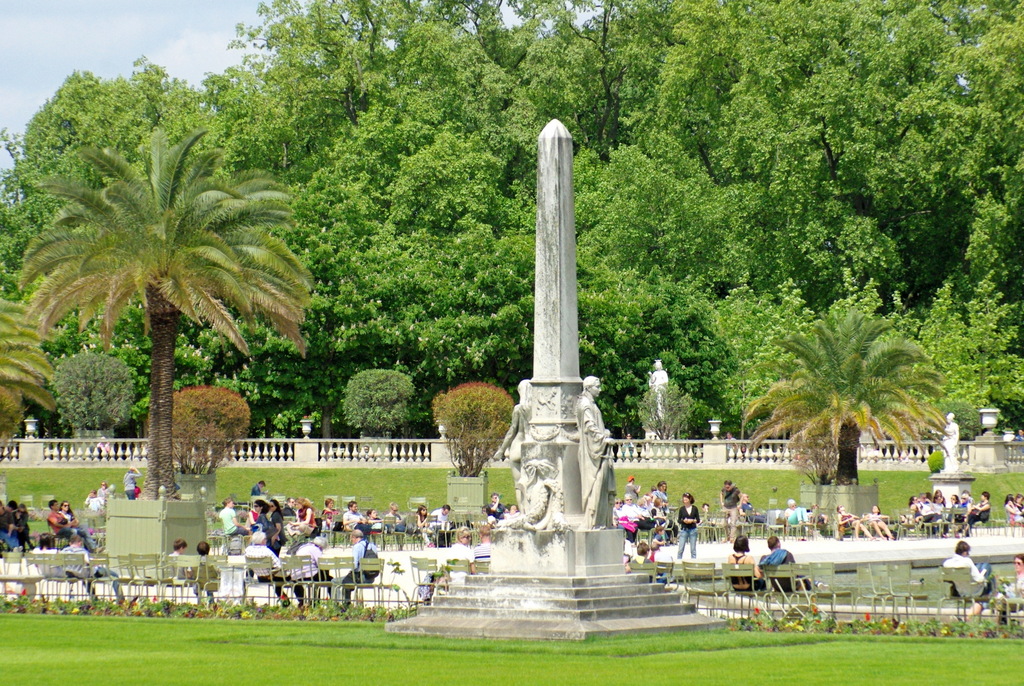
The Luxembourg Gardens house several facilities which bring joy to children and grown-ups alike:
- the real tennis court (jeu de paume),
- the French bowls ground (pétanque),
- the children’s playground,
- the wooden merry-go-round and
- the famous Guignol puppet show…

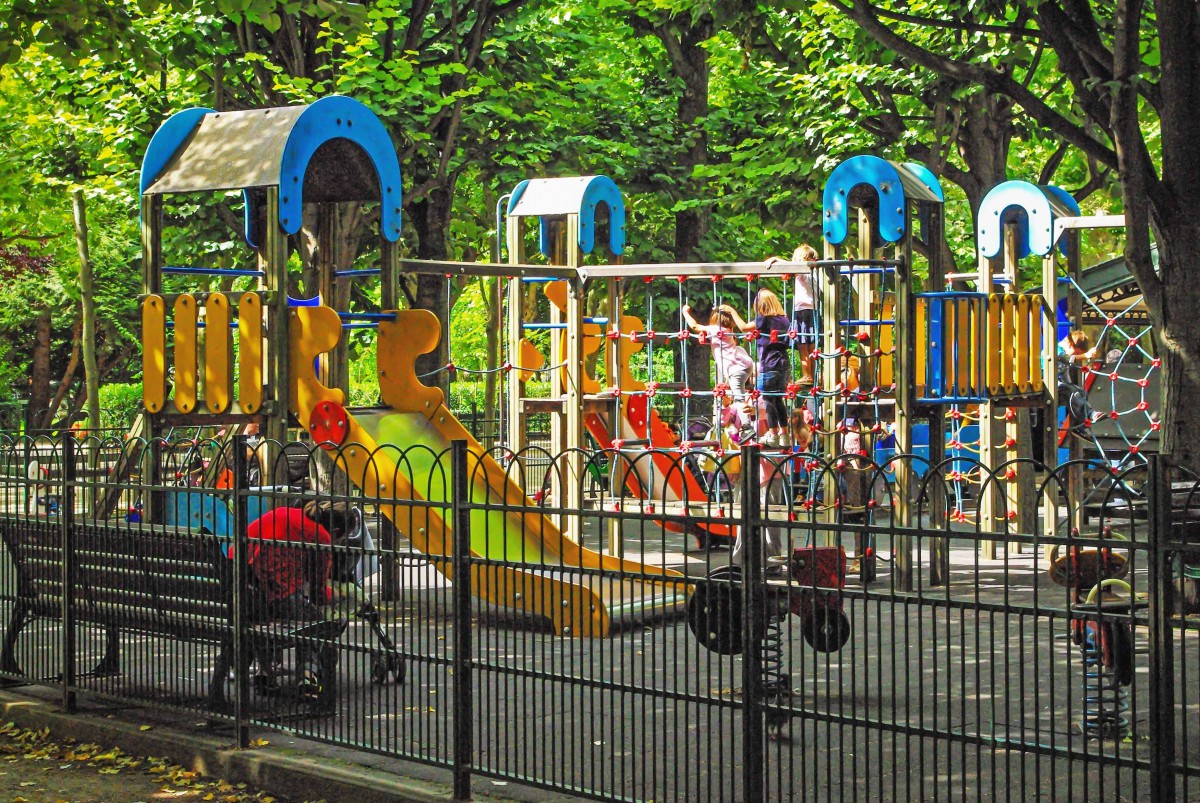

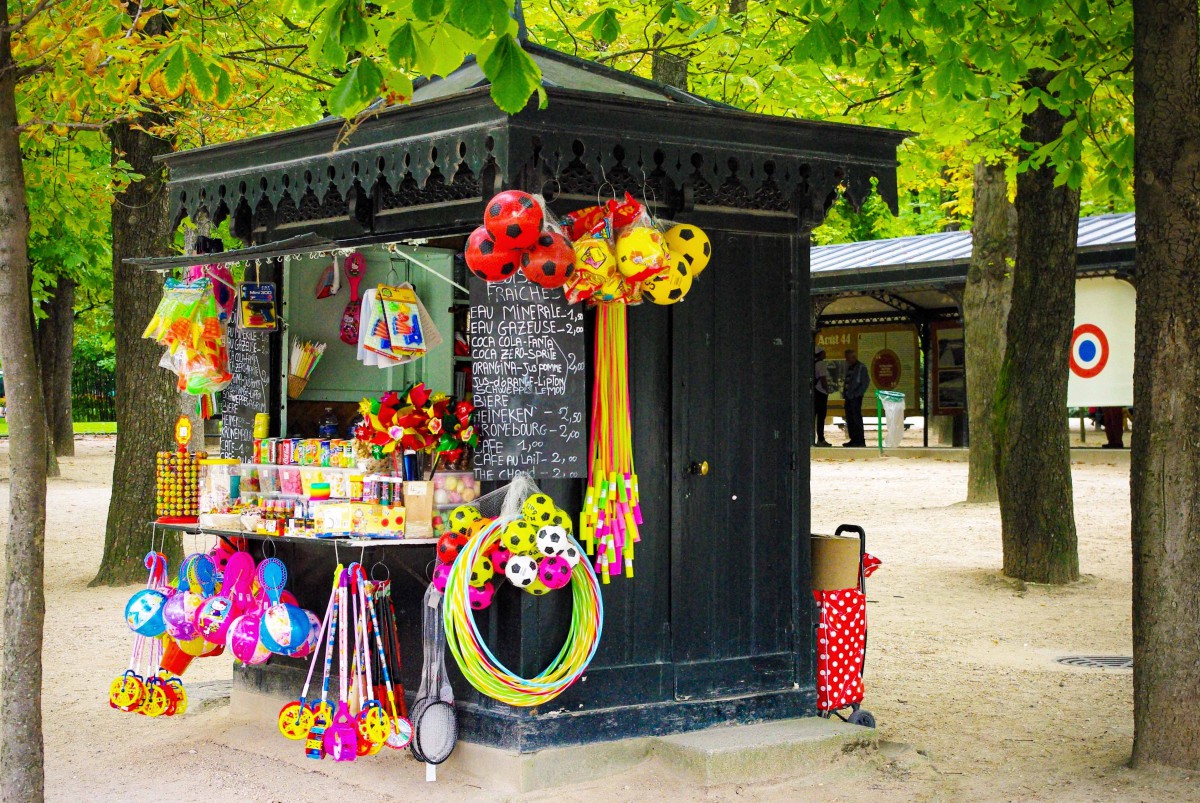
A beehive produces a few hundred kilos of honey yearly in the far southwest of the garden.
Initially established in 1856, the beehive was rebuilt in 1991.
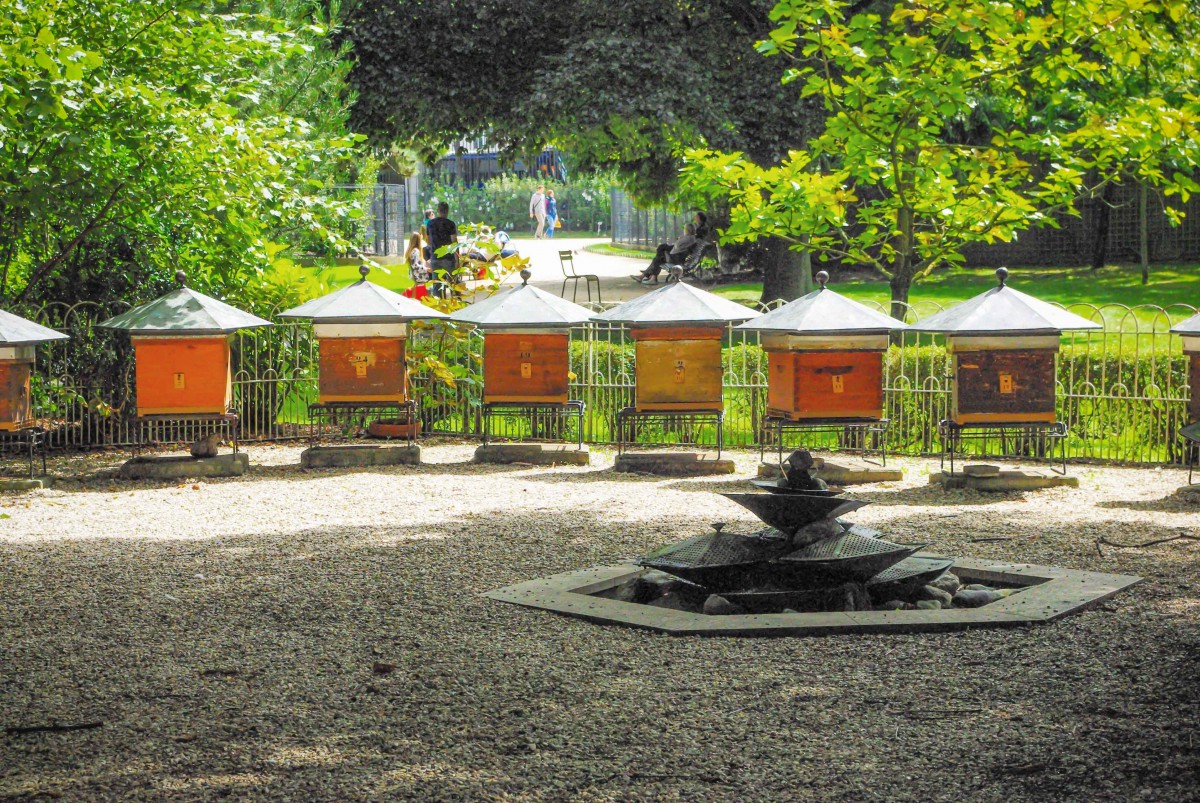
Not far is an orchard containing more than 700 apple and pear trees and grape vines.
The bandstand dates back to 1879 (it is contemporary with the wooden merry-go-round).
From time to time, it continues to host concerts for brass bands.
Paintings of the Luxembourg Gardens
Here’s three paintings representing the Jardin du Luxembourg:
Vincent Van Gogh: Allée dans le jardin du Luxembourg (1886), Clark Art Institute, Williamstown.

Henri Rousseau: Jardin du Luxembourg. Monument de Chopin (1909), Ermitage Museum, Saint-Petersburg.

Brasilian painter Eliseu Visconti: Jardin du Luxemburgo (1895).
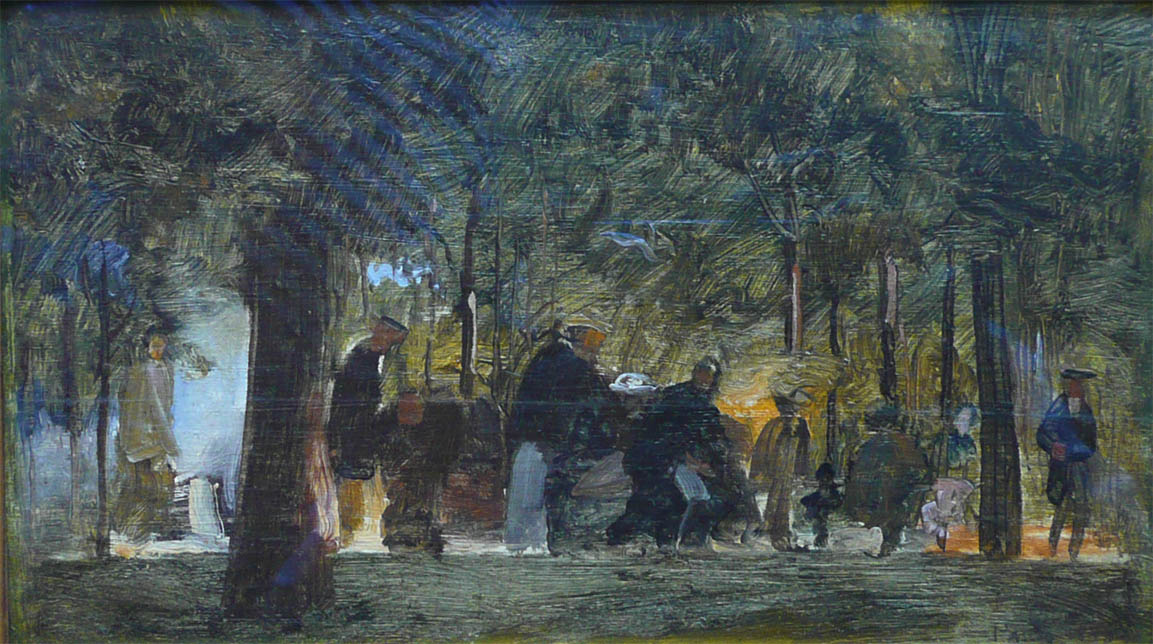
Jardin du Luxembourg: find out more!
Here’s a short selection of websites about the Luxembourg gardens:
- The French Senate (in French)
- Official Website of the Paris Tourist Board
- The Garden on Wikipedia
- Buy your ticket for the Musée du Luxembourg – Léon Monnet exhibition
How to get to the Jardin du Luxembourg
- Closest métro stations: Vavin (line 4), Saint-Sulpice (line 4), Notre-Dame-des-Champs (line 12)
- Closest RER station: Gare du Luxembourg (RER B)
Pin it for later

